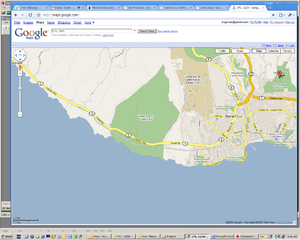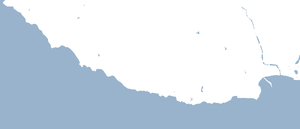imported>Anthony (create) |
m |
||
| (2 intermediate revisions by one other user not shown) | |||
| Line 10: | Line 10: | ||
Except at the pole, where the length of the top of the graticule is zero, a graticule is a trapezoid. The area of a trapezoid is 1/2(B1+B2)/H. Thus the area of a graticule whose base is at latitude L is: | Except at the pole, where the length of the top of the graticule is zero, a graticule is a trapezoid. The area of a trapezoid is 1/2(B1+B2)/H. Thus the area of a graticule whose base is at latitude L is: | ||
| − | A = 12 371.263 314 km | + | A = 12 371.263 314 km<sup>2</sup> * 1/2(cos(L)+cos(L+1)) |
| − | Example: [[Santa Cruz, California]], which is at [[36, -122]]. | + | Example: [[Santa Cruz, California]], which is at [[36,-122]]. |
| − | A = 12 371.263 314 km | + | A = 12 371.263 314 km<sup>2</sup> * 1/2(cos(36)+cos(37)) = 12 371.263 314 km<sup>2</sup> * 0.803 826 = 9 944.346 225 km<sup>2</sup>. |
| − | Playing with Google Maps and GIMP, I found that the total land area in the Santa Cruz graticule is 67.408 km | + | Playing with Google Maps and GIMP, I found that the total land area in the Santa Cruz graticule is 67.408 km<sup>2</sup>, which is 1/147.5 of the total area of the graticule. |
| + | |||
| + | [[Image:SCz-map.png|thumb|left|The land area of the Santa Cruz graticule. Placemark is at 37, -122.]] | ||
| + | [[Image:SCz-landmap.png|thumb|right|The land area within the graticule turned white. This image is 1.198% of the entire graticule.]] | ||
Latest revision as of 21:22, 2 March 2020
More exact values of the area of a graticule:
The equatorial circumference of the earth is 40 075.02 km, the meridional circumference is 40 007.86 km. We ignore the minor corrections required by the formulae for ellipsoids.
The height of one graticule is 1/360 of the meridional circumference, or 111.132 94 km. The width of a graticule varies from bottom to top. (Up is towards the nearest pole for the purposes of this exercise, though mathematically, using either pole will work.) The "base" of the graticule is at the latitude for which the graticule is named; the "top" is at one degree higher.
The length of the base is 1/360 of the equatorial circumference multiplied by the cosine of the latitude: B = 111.319 50 km * cos(L) (L in degrees)
Except at the pole, where the length of the top of the graticule is zero, a graticule is a trapezoid. The area of a trapezoid is 1/2(B1+B2)/H. Thus the area of a graticule whose base is at latitude L is:
A = 12 371.263 314 km2 * 1/2(cos(L)+cos(L+1))
Example: Santa Cruz, California, which is at 36,-122.
A = 12 371.263 314 km2 * 1/2(cos(36)+cos(37)) = 12 371.263 314 km2 * 0.803 826 = 9 944.346 225 km2.
Playing with Google Maps and GIMP, I found that the total land area in the Santa Cruz graticule is 67.408 km2, which is 1/147.5 of the total area of the graticule.

